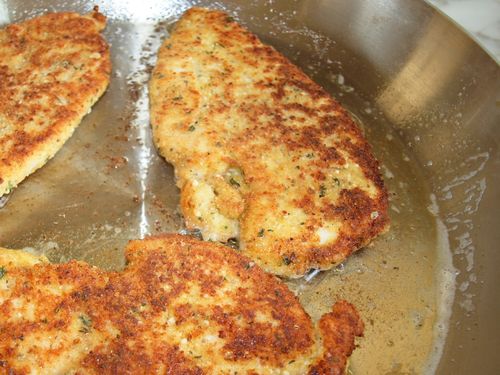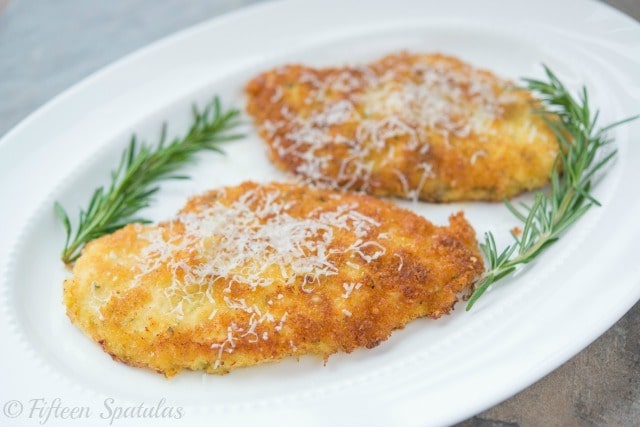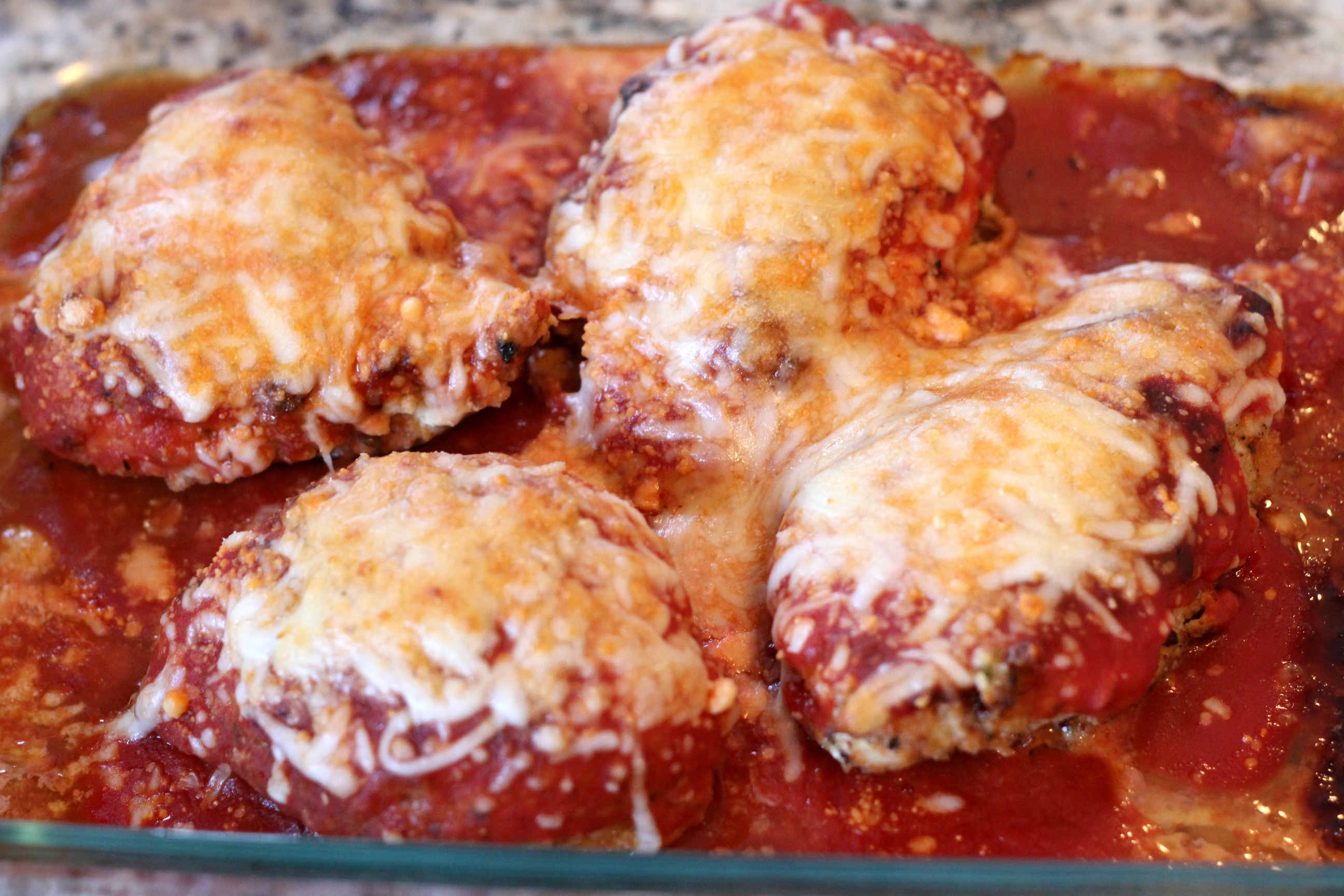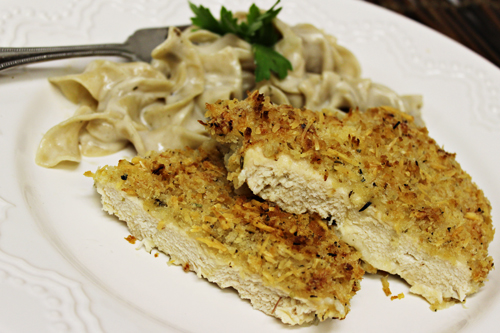Crispy Chicken Parmesan Recipe Biography
source (google.com.pk)I can count the number of times I've had truly bad chicken parm on one hand, and all of those situations involved alcohol, steam tables, and friends with loose morals (or, at the very least, questionable taste). Like pizza, if you order chicken parm—even at the chainiest of chain restaurants—you're going to get something pretty good. It's pretty hard to mess up a fried breaded chicken cutlet smothered with red sauce and melted mozzarella and Parmesan cheese.
The dish originates from Melanzane alla Parmigiana, the classic Italian dish of eggplant sautéed in olive oil and layered with tomato sauce and mozzarella cheese. Though the name means "eggplant in the style of Parma," a Northern Italian city, the dish originates in Southern Italy where eggplants, tomatoes, and olive oil are plentiful. In fact, real classic eggplant parm is made solely with mozzarella cheese—it doesn't necessarily have Parmesan at all.
Chicken made its appearance when Italian immigrants brought the dish to the U.S., a country where meat was both plentiful and cheap. Very quickly, the sautéed eggplant was replaced wholesale with breaded chicken cutlets (or veal cutlets, or even pork, as the case may be). Some time later, Parmesan cheese started becoming a standard addition (perhaps because the name seemed to imply it,* but more likely because it just tastes better with it), and an Italian-American classic was born.
* It reminds me a bit of how many Indian restaurants serve potatoes in their vindaloo, only becase "aloo" means potato in hindi. In reality, "vindaloo" comes from the Portuguese "vinha d'alhos," meaning wine and garlic—nothing to do with potatoes at all!
Since then, as often happens when things go mainstream, chicken parm has gone from being a beloved and once-a-year comfort food to an institutionalized, mass-produced, inoffensive staple.
My goal today is to fix that by bringing chicken parm back to its roots, optimizing every step, and creating a recipe that celebrates the dish in all of its cheesy, crispy, sauce-smothered, American glory.
Crumby Flavor
Let's start with the easiest bit. What's the blandest part of the chicken parm? Anyone?
That's right, the breading. The role of the breading in a chicken parm is twofold: first, it adds crunchy textures. Secondly (and no less importantly), it helps insulate the chicken as it cooks, mitigating the drying effect of frying.
The first step to better breading is using better bread. I tried using canned breadcrumbs, panko-style breadcrumbs, and crumbs made from a loaf of fresh high quality Italian bread, and crumbs made from bread that I first dehydrated in the oven partially. I applied all of them with the standard breading process:
First a quick dredge in flour (this gives the eggs a dry, rough surface to cling to—think of it as primer for your paint)...
...followed by a dip in beaten eggs...
...then a trip to the bread crumbs. I always like to pile breadcrumbs on top and press them down hard to make sure they adhere well.
The fresh bread was the best—it had the most unique structure with tons of craggy crusty bits—but it also was the most difficult to cook. Because of its high moisture content, it ended up sticking to the bottom of the skillet, requiring a bit of careful prying to flip the chicken without leaving the crust behind.
Breadcrumbs made from bread that I'd dehydrated in a low oven for half an hour were much easier to work with, though they weren't nearly as craggy. To solve this issue and get the best of both worlds, I decided to employ a trick I started using with my Chick-Fil-A clone recipe.
By adding a bit of buttermilk to the dry breadcrumb mixture and working it in with my fingertips, I created a breading that came pre-loaded with large, chunky nubs—the kind of chunky nubs that turn into extra-crispy bits as the chicken fries.
Check out this out:
That's texture just waiting to happen. In order to further enhance the coating, I also added just a touch of flour and buttermilk to the egg wash, adding more flavor and creating a thicker, more substantial layer for the crumbs to stick to.
As a final (and not minor) flavor boost, I decided to add some Parmesan cheese to my breading mixture. I added more and more until I finally settled on a mixture of about 1/3 Parmesan and 2/3 bread—any more and the mixture would become too cheesy and begin to melt off the chicken as soon as it hit the oil.
Frying
For the frying process, the goal is to get an even golden-brown crust on both surfaces. The absolute best way to do this it to actually deep-fry the chicken so that it's cooking from all sides quickly and simultaneously. It's not a particularly practical method at home, however, so we'll stick with the more traditional shallow-frying in a skillet.
The most important part of frying the chicken is to make sure your oil is at the right temperature. Too cold and your chicken will end up overcooking before it has a chance to fully brown and crisp (or worse, your coating will slip off the chicken if it doesn't seal up fast enough).
Too hot, and you end up with this, which, aside from looking a little bit like India, also has some problems.
The coating is burnt in spots, but almost completely raw in others. No good.
To make sure you're frying right, you should aim for a temperature of between 375 to 400°F to start. You can check this either with a totally awesome infrared thermometer like this, with a good instant read thermometer, or the old fashioned way: a little cube of bread dropped in should sizzle rapidly and brown in about 10 seconds. If it doesn't sizzle, wait longer. Browning too fast? Let the oil cool a bit.
Once the chicken is added, it'll drop down to around 325°F, and you should adjust the heat to maintain that temperature.
I like to fry in cast iron (nothing will help your seasoning more!), but a standard stainless steel or even a nonstick skillet will work fine. When adding the chicken to the pan, make sure to lay it into the pan from the tip down, slowly draping it away from you. Want to know the definition of pain? Try adding the chicken really fast, draping it towards you and watch as your body is showered with drops of hot oil.
Bonus macho points if you do this naked.
Place as many pieces of chicken as will fit in a single layer (I could fit three in my 12-inch cast iron skillet, sometimes only two if they were especially large) and let them cook without moving for about 30 seconds, then start swirling the pan, using a flexible slotted spatula to gently pry off any bits that are sticking to the bottom.
It's also good practice to lift the chicken slightly, allowing the oil underneath to redistribute and cook more evenly. Once they've turned golden brown on the bottom, use a fork in one hand to lift the cutlet, gently flipping it and catching it with your spatula to prevent it from splashing down into the hot oil.
As the chicken finishes cooking, lay it on a paper towel-lined plate to drain.
Cheese and Sauce
There's no real question as to what sauce we're going to use here. I spent a good deal of time developing this All-Day Stovetop Italian-American Red Sauce, and it's the best darn sauce I've ever had. If we're going into chicken parm, we're going in it to win it. (Though fine, if you want it a little quicker, you can use Daniel's awesome 40-minute red sauce.)
As for the cheese, I always figured that the higher the quality of the mozzarella, the better. But is this really the case?
I tried four different cheeses: an honest-to-goodness imported buffalo milk mozzarella from Italy, a high quality water-packed mozzarella made locally, a nationally-available ball of "fresh mozzarella" packed in a cryovac-style package, and a chunk of low-moisture mozzarella (the stuff we know as "pizza cheese" 'round here).
Surprisingly, the buffalo mozz wasn't the best. Rather than melting into a gooey layer like you want in a good chicken parm, it instead gave off a ton of moisture while simultaneously turning a little rubbery. The fresh local mozzarella suffered the same fate, though to a lesser degree. Of the two packaged mozzarellas, it was a toss up. The fresh mozzarella has the advantage of having a nice fresh milk flavor, while the aged mozzarella melts a little more easily into stretchy, gooey strands. It's really up to you.
In any case, cutting the cheese into cubes as opposed to grating it gives it superior melting properties, creating nice cheesy, gooey pockets. Tossing the mozzarella with some grated Parmigiano-Reggiano also adds flavor without detracting from its melt-ability.
Assembly
With the chicken fried, the sauce made, and the cheese tossed, assembly is pretty straightforward. You can work in a casserole dish, individual oven-safe serving dishes, or a large oven-safe platter.
I first laid down a thick layer of sauce...
...then topped it with the chicken...
...followed by more sauce...
...and a thick spread of cheese over the top. I intentionally left the edges of the chicken uncovered. Like a good pizza, I want there to be some amount of soft, sauce-soaked breading, but I also want to make sure that there are crispy edges sticking out as well for textural contrast.
After baking it in a 425°F oven until the cheese melted, I tasted it.
The sauce, cheese, and crust were spot-on, but the chicken itself was still frustratingly dry. What's up with that?
Try a Little Tenderness
Quick fact #1: Chicken breast is pretty much the driest cut out meat out there, period. With very little fat and almost no connective tissue, it's the kind of meat that turns to tough, chalky sawdust when even slightly overcooked.
Quick fact #2: Frying is one of the most violent ways you can cook food. It heats very rapidly and unforgivingly, making it more likely for the food to dry out than with a more delicate method like steaming or sous-vide cooking.
On top of that, a chicken breast is unevenly shaped. There are thick areas and thin areas, which leads to uneven cooking—by the time the thick areas are cooked through, the thin areas are hopelessly overcooked. How do we solve these problems?
Well, let's start with the first trick that the classic method utilizes: pounding. Pounding not only tenderizes by breaking down some of the tougher connections between muscle fibers, but it also evens out those thick and thin spots.
We start by splitting a chicken breast half in half horizontally with a very sharp knife.
Then place that chicken breast half in a zipper-lock bag and pound it out to an even thickness.
With classic chicken parm, you'd jump straight from this step to the breading and frying stages. But I wondered what would happen if I were to add a brining step here. When you soak chicken in a salty solution, that salt will dissolve some of its muscle proteins—mainly myosin—which in turn allows it to retain more moisture as it cooks.
The brine certainly helped, but then it occurred to me: how is a breaded chicken cutlet used for chicken parm all that different from, say, Southern-style fried chicken? Aside from its breading (chicken parm uses breadcrumbs, Southern-fried uses a flour dredging), it has the same problems of dryness and toughness that need to be dealt with. What if I were to adapt a Southern-style buttermilk soak?
I was already adding a touch of buttermilk to my breadcrumb mixture, so it was an easy leap to make.
I pounded out a batch of chicken breasts and added them to a buttermilk brine seasoned with lots of salt, pepper, and garlic, then transferred the mixture to a zipper lock bag and let it rest overnight. Buttermilk, with its mild acidity not only improves the flavor of chicken, but also further tenderizes it.
The next day, I breaded and fried the cutlets just as I did with the standard chicken breast.
The results were pretty astounding. Here was chicken breast that even after being fried and baked in the oven, still maintained all the juiciness of the best Southern-style fried chicken, with a smooth, tender texture and not a hint of stringiness or graininess.
On top of that, the buttermilk only served to enhance the cheesiness I'd built in with the Parmesan-spiked crust and the two types of melted cheese topping it.
A quick sprinkle of chopped fresh parsley leaves and some more grated Parmigiano-Reggiano added just as it came out of the oven was all the dish needed.
Crispy, crunchy, moist, and flavor-packed, this is everything you could wish for in a good chicken Parmesan, and all it took was a little inspiration from down South to pull it off.
The next question is, what happens if we go full Southern, skip the breading entirely, and add our sauce and cheese to a classic flour-dredged, Southern-fried chicken breast? Why, with a recipe like that, one could perhaps—dare I say it—rule the world?
Crispy Chicken Parmesan Recipe
Crispy Chicken Recipe Sandwich Wings Costoletta Salad Burger Chinese Crispers Chili's Strips Photos

Crispy Chicken Parmesan Recipe
Crispy Chicken Recipe Sandwich Wings Costoletta Salad Burger Chinese Crispers Chili's Strips Photos

Crispy Chicken Parmesan Recipe
Crispy Chicken Recipe Sandwich Wings Costoletta Salad Burger Chinese Crispers Chili's Strips Photos

Crispy Chicken Parmesan Recipe
Crispy Chicken Recipe Sandwich Wings Costoletta Salad Burger Chinese Crispers Chili's Strips Photos

Crispy Chicken Parmesan Recipe
Crispy Chicken Recipe Sandwich Wings Costoletta Salad Burger Chinese Crispers Chili's Strips Photos

Crispy Chicken Parmesan Recipe
Crispy Chicken Recipe Sandwich Wings Costoletta Salad Burger Chinese Crispers Chili's Strips Photos

Crispy Chicken Parmesan Recipe
Crispy Chicken Recipe Sandwich Wings Costoletta Salad Burger Chinese Crispers Chili's Strips Photos

Crispy Chicken Parmesan Recipe
Crispy Chicken Recipe Sandwich Wings Costoletta Salad Burger Chinese Crispers Chili's Strips Photos

Crispy Chicken Parmesan Recipe
Crispy Chicken Recipe Sandwich Wings Costoletta Salad Burger Chinese Crispers Chili's Strips Photos

Crispy Chicken Parmesan Recipe
Crispy Chicken Recipe Sandwich Wings Costoletta Salad Burger Chinese Crispers Chili's Strips Photos

Crispy Chicken Parmesan Recipe
Crispy Chicken Recipe Sandwich Wings Costoletta Salad Burger Chinese Crispers Chili's Strips Photos

Crispy Chicken Parmesan Recipe
Crispy Chicken Recipe Sandwich Wings Costoletta Salad Burger Chinese Crispers Chili's Strips Photos

Crispy Chicken Parmesan Recipe
Crispy Chicken Recipe Sandwich Wings Costoletta Salad Burger Chinese Crispers Chili's Strips Photos

Crispy Chicken Parmesan Recipe
Crispy Chicken Recipe Sandwich Wings Costoletta Salad Burger Chinese Crispers Chili's Strips Photos

Crispy Chicken Parmesan Recipe
Crispy Chicken Recipe Sandwich Wings Costoletta Salad Burger Chinese Crispers Chili's Strips Photos
No comments:
Post a Comment